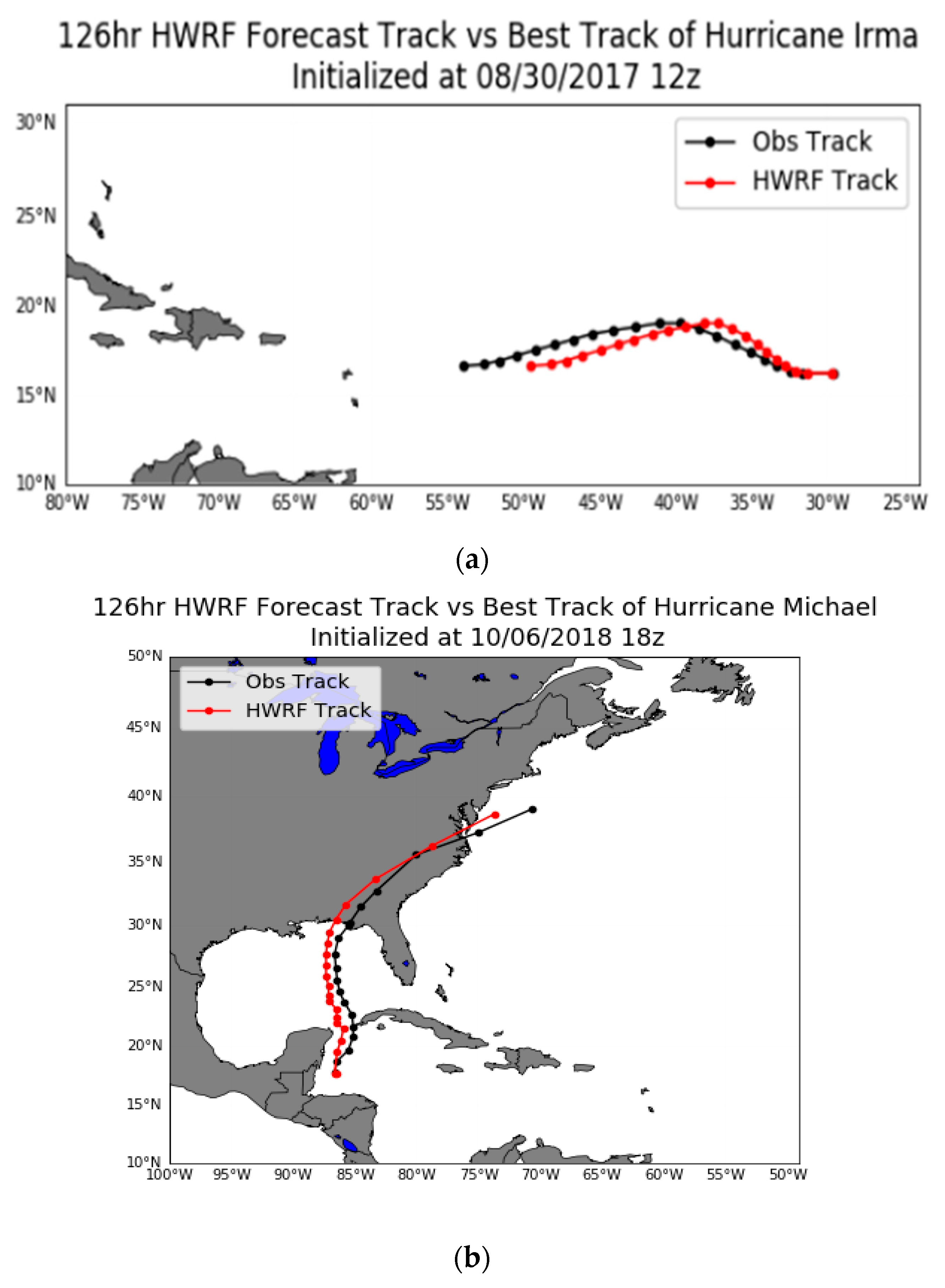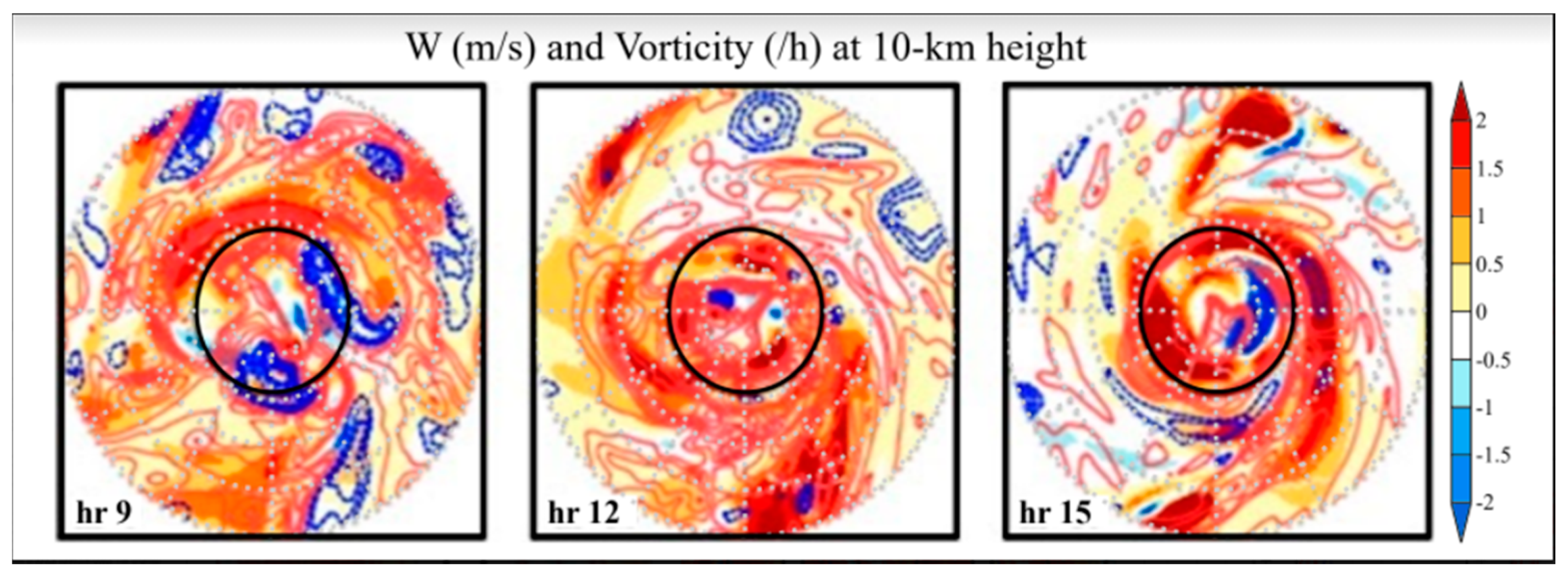Understanding the Role of Mean and Eddy Momentum Transport in the Rapid Intensification of Hurricane Irma (2017) and Hurricane Michael (2018)
Abstract
:1. Introduction
2. Case Descriptions
2.1. Hurricane Irma (2017)
2.2. Hurricane Michael (2018)
3. Experimental Design and Methods
3.1. Model Description
3.2. Model Simulations, Verification, and Analysis
3.3. Tangential Wind Momentum Budget Terms

4. Results
4.1. Model Verification: Track and Intensity
4.2. Large-Scale Environment
4.3. TC Inner Core
4.4. Tangential Wind Momentum Budgets
5. Discussions and Conclusions
- (1)
- How did the environments surrounding Hurricanes Irma and Michael modulate the evolution of TC structure in each case, especially the inner core?
- (2)
- How and why did Hurricane Michael rapidly intensify into a major hurricane despite hostile environmental conditions?
- (3)
- What was the role of eddy and mean transport terms in the intensification processes for Hurricanes Irma and Michael?
Author Contributions
Funding
Data Availability Statement
Acknowledgments
Conflicts of Interest
References
- 2019 HFIP R&D Activities Summary: Recent Results and Operational Implementation. HFIP Technical Report: HFIP 2018-1. Available online: http://www.hfip.org/documents/HFIP_AnnualReport_FY2019.pdf (accessed on 13 January 2021).
- Kaplan, J.; DeMaria, M.; Knaff, J.A. A revised tropical cyclone rapid intensification index for the Atlantic and eastern North Pacific basins. Weather Forecast. 2010, 25, 220–241. [Google Scholar] [CrossRef]
- Willoughby, H.E.; Clos, J.A.; Shoreibah, M.G. Concentric eyewalls, secondary wind maxima, and the evolution of the hurricane vortex. J. Atmos. Sci. 1982, 39, 395–411. [Google Scholar] [CrossRef]
- Kossin, J.; Schubert, W.H. Mesovortices, polygonal flow patterns, and rapid pressure falls in hurricane-like vortices. J. Atmos. Sci. 2001, 58, 2196–2209. [Google Scholar] [CrossRef]
- Eastin, M.D.; Gray, W.M.; Black, P.G. Buoyancy of convective vertical motions in the inner core of intense hurricanes. Part I: General statistics. Mon. Wea. Rev. 2005, 133, 188–208. [Google Scholar] [CrossRef]
- Eastin, M.D.; Gray, W.M.; Black, P.G. Buoyancy of convective vertical motions in the inner core of intense hurricanes. Part II: Case studies. Mon. Wea. Rev. 2005, 133, 209–227. [Google Scholar] [CrossRef]
- Chen, H.; Gopalakrishnan, S. A study on the asymmetric rapid intensification of Hurricane Earl (2010) using the HWRF system. J. Atmos. Sci. 2015, 72, 531–550. [Google Scholar] [CrossRef]
- Kaplan, J.; DeMaria, M. Large scale characteristics of rapidly intensifying tropical cyclones in the North Atlantic basin. Weather Forecast. 2003, 18, 1093–1108. [Google Scholar] [CrossRef] [Green Version]
- Schubert, W.H.; Hack, J.J. Inertial stability and tropical cyclone development. J. Atmos. Sci. 1982, 39, 1687–1697. [Google Scholar] [CrossRef]
- Frank, W.M.; Ritchie, E.A. Effects of vertical wind shear on the intensity and structure of numerically simulated hurricanes. Mon. Wea. Rev. 2001, 129, 2249–2269. [Google Scholar] [CrossRef]
- Kaplan, J.; Rozoff, C.M.; DeMaria, M.; Sampson, C.R.; Kossin, J.P.; Velden, C.S.; Cione, J.J.; Dunion, J.P.; Knaff, J.A.; Zhang, J.A.; et al. Evaluating environmental impacts on tropical cyclone rapid intensification predictability utilizing statistical models. Weather Forecast. 2015, 30, 1374–1396. [Google Scholar] [CrossRef]
- Bhalachandran, S.; Nadimpalli, R.; Osuri, K.K.; Marks, F.D., Jr.; Gopalakrishnan, S.; Subramanian, S.; Mohanty, U.C.; Niyogi, D. On the processes influencing rapid intensity changes of tropical cyclones over the Bay of Bengal. Sci. Rep. 2019, 9, 3382. [Google Scholar] [CrossRef]
- Tang, B.; Emanuel, K. Midlevel ventilation’s constraint on tropical cyclone intensity. J. Atmos. Sci. 2010, 67, 1817–1830. [Google Scholar] [CrossRef] [Green Version]
- Riemer, M.; Montgomery, M.T.; Nicholls, M.E. A new paradigm for intensity modification of tropical cyclones: Thermodynamic impact of vertical wind shear on the inflow layer. Atmos. Chem. Phys. 2010, 10, 3163–3188. [Google Scholar] [CrossRef] [Green Version]
- Molinari, J.; Dodge, P.; Vollaro, D.; Corbosiero, K.L.; Marks, F., Jr. Mesoscale aspects of the downshear reformation of a tropical cyclone. J. Atmos. Sci. 2006, 63, 341–354. [Google Scholar] [CrossRef] [Green Version]
- Molinari, J.; Vollaro, D. Rapid intensification of a sheared tropical storm. Mon. Weather Rev. 2010, 138, 3869–3885. [Google Scholar] [CrossRef]
- Rios-Berrios, R.; Torn, R.D.; Davis, C.A. An ensemble approach to investigate tropical cyclone intensification in a sheared environment. Part I: Katia (2011). J. Atmos. Sci. 2016, 73, 71–93. [Google Scholar] [CrossRef]
- Leighton, H.; Gopalakrishnan, S.; Zhang, J.A.; Rogers, R.F.; Zhang, Z.; Tallapragada, V. Azimuthal distribution of deep convection, environmental factors and tropical cyclone rapid intensification: A perspective from HWRF ensemble forecasts of Hurricane Edouard (2014). J. Atmos. Sci. 2018, 75, 275–295. [Google Scholar] [CrossRef]
- Gopalakrishnan, S.; Osuri, K.; Marks, F.; Mohanty, U.C. An inner-core analysis of the axisymmetric and asymmetric intensification of tropical cyclones: Influence of shear. Mausam 2019, 70, 667–690. [Google Scholar]
- Cangialosi, J.P.; Latto, A.S.; Berg, R. National Hurricane Center Tropical Cyclone Report: Hurricane Irma. Natl. Hurric. Cent. 2018, 1–111. Available online: https://www.nhc.noaa.gov/data/tcr/AL112017_Irma.pdf (accessed on 17 January 2021).
- Bevin, J.L., II; Berg, R.; Hagen, A. National Hurricane Center Tropical Cyclone Report: Hurricane Michael. Natl. Hurric. Cent. 2019, 1–86. Available online: https://www.nhc.noaa.gov/data/tcr/AL142018_Michael.pdf (accessed on 17 January 2021).
- Gopalakrishnan, S.G.; Marks, F.; Zhang, X.J.; Bao, J.W.; Yeh, K.S.; Atlas, R. The Experimental HWRF System: A Study on the Influence of Horizontal Resolution on the Structure and Intensity Changes in Tropical Cyclones Using an Idealized Framework. Mon. Weather Rev. 2011, 139, 1762–1784. [Google Scholar] [CrossRef]
- Gopalakrishnan, S.G.; Goldenberg, S.; Quirino, T.; Zhang, X.; Marks, F., Jr.; Yeh, K.S.; Atlas, R.; Tallapragada, V. Toward Improving High-Resolution Numerical Hurricane Forecasting: Influence of Model Horizontal Grid Resolution, Initialization and Physics. Weather Forecast. 2012, 27, 647–666. [Google Scholar] [CrossRef]
- Gopalakrishnan, S.G.; Marks, F.D.; Zhang, J.A.; Zhang, X.; Bao, W.J.; Tallapragada, V. A study of the impacts of vertical diffusion on the structure and intensity of the tropical cyclones using the high resolution HWRF system. J. Atmos. Sci. 2013, 70, 524–541. [Google Scholar] [CrossRef]
- Bao, J.-W.; Gopalakrishnan, S.G.; Michelson, S.A.; Marks, F.D.; Montgomery, M.T. Impact of physics representations in the HWRFX on simulated hurricane structure and pressure–wind relationships. Mon. Weather Rev. 2012, 140, 3278–3299. [Google Scholar] [CrossRef] [Green Version]
- Tallapragada, V.; Kieu, C.; Kwon, Y.; Trahan, S.; Liu, Q.; Zhang, Z.; Kwon, I.H. Evaluation of storm structure from the operational HWRF model during 2012 implementation. Mon. Weather Rev. 2014, 142, 4308–4325. [Google Scholar] [CrossRef]
- Atlas, R.; Tallapragada, V.; Gopalakrishnan, S.G. Advances in tropical cyclone intensity forecasts. Mar. Technol. J. 2015, 49, 149–160. [Google Scholar] [CrossRef]
- Janjić, Z.I.; Gerrity, J.P., Jr.; Nickovic, S. An alternative approach to nonhydrostatic modeling. Mon. Weather Rev. 2001, 129, 1164–1178. [Google Scholar] [CrossRef]
- Biswas, M.K.; Abarca, S.; Bernardet, L.; Ginis, I.; Grell, E.; Iacono, M.; Kalina, E.; Liu, B.; Liu, Q.; Marchok, T.; et al. Hurricane Weather Research and Forecasting (HWRF) Model: 2018. Sci. Doc. 2018. Available online: https://dtcenter.org/HurrWRF/users/docs/index.php (accessed on 7 January 2021).
- National Centers for Environmental Prediction; National Weather Service; NOAA; U.S. Department of Commerce. 2015, Updated Daily. NCEP GDAS/FNL 0.25 Degree Global Tropospheric Analyses and Forecast Grids. Research Data Archive at the National Center for Atmospheric Research, Computational and Information Systems Laboratory. Available online: https://rda.ucar.edu/datasets/ds083.3/ (accessed on 27 January 2021). [CrossRef]
- Montgomery, M.T.; Kilroy, G.; Smith, R.K.; Črnivec, N. Contribution of mean and eddy momentum processes to tropical cyclone intensification. Q. J. R. Meteorol. Soc. 2020, 146, 3101–3117. [Google Scholar] [CrossRef]
- Persing, J.; Montgomery, M.T.; McWilliams, J.C.; Smith, R.K. Asymmetric and axisymmetric dynamics of tropical cyclones. Atmos. Chem. Phys. 2013, 13, 12299–12341. [Google Scholar] [CrossRef] [Green Version]
- Hendricks, E.A.; Peng, M.S.; Fu, B.; Li, T. Quantifying Environmental Control on Tropical Cyclone Intensity Change. Mon. Weather Rev. 2010, 138, 3243–3271. [Google Scholar] [CrossRef] [Green Version]
- Rappaport, E.N.; Franklin, J.L.; Avila, L.A.; Baig, S.R.; Beven, J.L.; Blake, E.S.; Burr, C.A.; Jiing, J.G.; Juckins, C.A.; Knabb, R.D.; et al. Advances and challenges at the National Hurricane Center. Weather Forecast. 2009, 24, 395–419. [Google Scholar] [CrossRef] [Green Version]
- Wu, L.; Su, H.; Fovell, R.G.; Wang, B.; Shen, J.T.; Kahn, B.H.; Hristova-Veleva, S.M.; Lambrigtsen, B.H.; Fetzer, E.J.; Jiang, J.H. Relationship of environmental relative humidity with North Atlantic tropical cyclone intensity and intensification rate. Geophys. Res. Lett 2012, 39, L2080. [Google Scholar] [CrossRef] [Green Version]
- Tang, B.; Emanuel, K. Sensitivity of tropical cyclone intensity to ventilation in an axisymmetric model. J. Atmos. Sci. 2012, 69, 2394–2413. [Google Scholar] [CrossRef]
- Ge, X.; Li, T.; Peng, M. Effects of Vertical Shears and Midlevel Dry Air on Tropical Cyclone Developments. J. Atmos. Sci. 2013, 70, 3859–3875. [Google Scholar] [CrossRef]
- Tao, D.; Zhang, F. Effect of environmental shear, sea surface temperature, and ambient moisture on the formation and predictability of tropical cyclones: An ensemble mean perspective. J. Adv. Model. Earth Syst. 2014, 6, 384–404. [Google Scholar] [CrossRef]
- Hendricks, E.A.; Montgomery, M.T.; Davis, C.A. The role of “vortical” hot towers in the formation of tropical cyclone Diana (1984). J. Atmos. Sci. 2004, 61, 1209–1232. [Google Scholar] [CrossRef] [Green Version]
- Yang, B.; Wang, Y.Q.; Wang, B. The effect of internally generated inner-core asymmetries on tropical cyclone potential intensity. J.Atmos.Sci. 2007, 64, 1165–1188. [Google Scholar] [CrossRef] [Green Version]
- Smith, R.K.; Montgomery, M.T. Toward clarity on understanding tropical cyclone intensification. J. Atmos. Sci. 2015, 72, 3020–3031. [Google Scholar] [CrossRef]
- Nguyen, S.; Smith, R.; Montgomery, M. Tropical-cyclone intensification and predictability in three dimensions. Q. J. R. Meteorol. Soc. 2008, 134, 563–582. [Google Scholar]
- Zhang, D.L.; Liu, Y.B.; Yau, M.K. A multiscale numerical study of Hurricane Andrew (1992). Part IV: Unbalanced flows. Mon.Weather Rev. 2001, 129, 92–107. [Google Scholar] [CrossRef]
- Montgomery, M.T.; Nicholls, M.E.; Cram, T.A.; Saunders, A.B. A vortical hot tower route to tropical cyclogenesis. J. Atmos. Sci. 2006, 63, 355–386. [Google Scholar] [CrossRef] [Green Version]
- Montgomery, M.T.; Smith, R.K. Paradigms for tropical cyclone intensification. Aust. Meteorol. Oceanogr. J. 2014, 64, 37–66. [Google Scholar] [CrossRef]
- Rogers, R.F.; Reasor, P.D.; Zhang, J.A. Multiscale Structure and Evolution of Hurricane Earl (2010) during Rapid Intensification. Monthly Weather Review. 2015, 143, 536–562. [Google Scholar] [CrossRef]
- Corbosiero, K.L.; Molinari, J. The effects of vertical wind shear on the distribution of convection in tropical cyclones. Mon. Weather Rev. 2002, 130, 2110–2123. [Google Scholar] [CrossRef] [Green Version]
- Corbosiero, K.L.; Molinari, J. The relationship between storm motion, vertical wind shear, and convective asymmetries in tropical cyclones. J. Atmos. Sci. 2003, 60, 366–376. [Google Scholar] [CrossRef]
- Rogers, R.; Reasor, P.; Lorsolo, S. Airborne Doppler observations of the inner-core structural differences between intensifying and steady-state tropical cyclones. Mon. Weather Rev. 2013, 141, 2970–2991. [Google Scholar] [CrossRef]
- Rappin, E.D.; Morgan, M.C.; Tripoli, G.J. The Impact of Outflow Environment on Tropical Cyclone Intensification and Structure. J. Atmos. Sci. 2011, 68, 177–194. [Google Scholar] [CrossRef]















Publisher’s Note: MDPI stays neutral with regard to jurisdictional claims in published maps and institutional affiliations. |
© 2021 by the authors. Licensee MDPI, Basel, Switzerland. This article is an open access article distributed under the terms and conditions of the Creative Commons Attribution (CC BY) license (https://creativecommons.org/licenses/by/4.0/).
Share and Cite
Green, A.; Gopalakrishnan, S.G.; Alaka, G.J., Jr.; Chiao, S. Understanding the Role of Mean and Eddy Momentum Transport in the Rapid Intensification of Hurricane Irma (2017) and Hurricane Michael (2018). Atmosphere 2021, 12, 492. https://doi.org/10.3390/atmos12040492
Green A, Gopalakrishnan SG, Alaka GJ Jr., Chiao S. Understanding the Role of Mean and Eddy Momentum Transport in the Rapid Intensification of Hurricane Irma (2017) and Hurricane Michael (2018). Atmosphere. 2021; 12(4):492. https://doi.org/10.3390/atmos12040492
Chicago/Turabian StyleGreen, Alrick, Sundararaman G. Gopalakrishnan, Ghassan J. Alaka, Jr., and Sen Chiao. 2021. "Understanding the Role of Mean and Eddy Momentum Transport in the Rapid Intensification of Hurricane Irma (2017) and Hurricane Michael (2018)" Atmosphere 12, no. 4: 492. https://doi.org/10.3390/atmos12040492
APA StyleGreen, A., Gopalakrishnan, S. G., Alaka, G. J., Jr., & Chiao, S. (2021). Understanding the Role of Mean and Eddy Momentum Transport in the Rapid Intensification of Hurricane Irma (2017) and Hurricane Michael (2018). Atmosphere, 12(4), 492. https://doi.org/10.3390/atmos12040492







